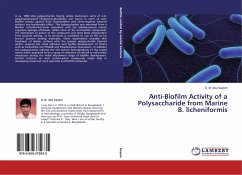A ca. 1800 kDA polysaccharide having simple monomeric units of -D-galactopyranosyl-(1 2)-glycerol-phosphate was found to exert an anti-biofilm activity against both Gram-positive and Gram-negative bacteria without any bactericidal effect. This polysaccharide was extracted from a Bacillus licheniformis strain associated with the Mediterranean marine organism Spongia officinalis. Unlike most of the anti-biofilm compounds, the mechanism of action of the compound was most likely independent from quorum sensing, as its structure is unrelated to any of the so far known quorum sensing molecules. Other experiments revealed that treatment of abiotic surfaces with the present polysaccharide blocked and/or reduced the initial adhesion and biofilm development of strains such as Escherichia coli PHL628 and Pseudomonas fluorescens. In addition the polysaccharide reduced the cell surface hydrophobicity of the tested strains which appeared to be a cause of reduction of cell-cell or cell-surface interaction during the initial attachment stage of biofilm development. Further research on such surface-active compounds might help in developing novel and more potential anti-biofilm molecules.
Bitte wählen Sie Ihr Anliegen aus.
Rechnungen
Retourenschein anfordern
Bestellstatus
Storno

